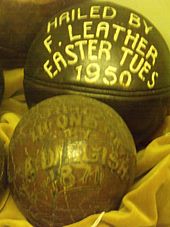Uppies and Downies
Uppies and Downies is a version of Hand Ba game, with roots in even earlier games,[1][2][3][4] played in Workington, West Cumbria, England. The modern tradition began some time in the latter half of the 19th century, with the match played annually at Easter to raise money for local charities.[5][6][7]
The game
The object of the game is to "hail the ball" (throw it up in the air three times) at the opposing team's goal. The Downies' goal is a capstan on the Prince of Wales' dock, while the Uppies' is the gates of Workington Hall Parklands.

There are no other ostensible rules of play and the game is primarily a rough and tumble scrum interspersed with break-away sprints by members of one team or the other, with some similarities to rugby. Some players from outside Workington take part, especially fellow West Cumbrians from Whitehaven and Maryport, resulting in about a thousand players on each team.[8]
The ball

An Uppies and Downies ball is made from four pieces of cow leather. It is 21 inches (53 cm) in circumference and weighs about two and a half pounds (1.1 kg). Only three hand-made balls are produced every year and each is dated.
Prizes
The player who hails the ball gets to keep the ball and will take the ball into the Town centre for people to get photos with for donations.
Socioeconomics
Uppies and Downies refer to the residents of the top (East) and bottom (West) of the town, which slopes down towards the sea. In the modern incarnation of the game, the Downies were originally residents of the marsh and quay, a working class area of the town demolished in the early 1980s and traditionally looked down at by the more affluent top of the town, where the local petty bourgeoisie lived.
Safety concerns
Due to its unpredictability, the game can spill over into the town centre. In the past, police have issued safety advice to visitors and local parents warning of getting caught up in the inevitable rough and physical encounter.[9]
Statues
A pair of coal-black iron-ore coloured figure statues created by Maryport sculptor Colin Telfer depict the Easter mass event; one stands outside Workington Hall, and the other at the town harbour.[10][11]
Threat from supermarket development
In 2009, proposed development plans to build a Tesco Extra store on the Cloffocks threatened the future of the event.[12]
See also
References
- ^ Hugh Hornby; Simon Inglis (2007). Uppies and Downies: The Extraordinary Football Games of Britain. English Heritage. ISBN 1-905624-64-6.
- ^ "The Uppies and Downies of England's Great Traditions". The Whitehaven News. 15 February 2008. Archived from the original on 3 December 2013. Retrieved 24 November 2013.
- ^ "Football Extraordinary (Timaru Herald, Volume LXII, Issue 2977, 14 June 1899, Page 4)". National Library of New Zealand.
- ^ Thomas S. Henricks (1991). Disputed Pleasures: Sport and Society in Preindustrial England. Greenwood Publishing Group. ISBN 0-313-27453-3.
- ^ Andy Byers (3 September 2009). "Don't View Uppies and Downies Through Rose Tinted Spectacles". Times & Star. Archived from the original on 2 December 2013. Retrieved 24 November 2013.
- ^ Safira Ali (2 May 2008). "Uppies and Downies raise £7,000 for RNLI". Times & Star. Archived from the original on 2 December 2013. Retrieved 24 November 2013.
- ^ P Cram (24 February 2006). "Uppies and Downies Worldwide". Times & Star. Archived from the original on 24 November 2013. Retrieved 24 November 2013.
- ^ "Uppies & Downies" (PDF). Played in Britain.
- ^ "Police Issue Uppies & Downies Warning". Times & Star. 21 April 2006.
- ^ "Artist Captures Uppies and Downies". News and Star. 9 May 2008. Archived from the original on 3 December 2013. Retrieved 24 November 2013.
- ^ "Workington's Uppies and Downies Statues Will be Repaired". Times & Star. 20 April 2009.
- ^ Martin Wainwright; Helen Carter (11 January 2013). "Uppies beat downies – but Tesco plans threaten medieval sporting tradition". The Guardian.

